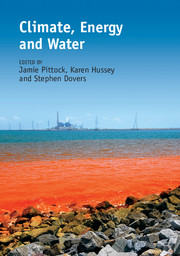Book contents
- Frontmatter
- Contents
- List of contributors
- Acknowledgements
- 1 Justifying, extending and applying “nexus” thinking in the quest for sustainable development
- 2 Water resources, climate change and energy
- 3 Implications of climate change for energy systems in a multisectoral context
- 4 Fossil fuels and water: A complex and evolving relationship
- 5 Renewable energy and water
- 6 Hydropower within the climate, energy and water nexus
- 7 Water and biofuels
- 8 Trade-offs and synergies between water and energy use in rural Australia
- 9 Management of the urban energy-water nexus
- 10 Managing the electricity-water nexus in China, France, India and the United States
- 11 Cross-sectoral governance of the climate, energy and water sectors: A ‘Rubik's cube’ analysis of cross-sectoral co-ordination
- 12 Regulation of the nexus
- 13 Climate, energy and water: the potential roles and limitations of markets
- 14 Strategies to mainstream climate change, energy, water and food security nexus knowledge and skills
- 15 A nexus of nexuses: systemic governance for climate response
- 16 Integrated modelling of the energy-water nexus in the American West
- 17 Biodiversity and the climate, energy and water nexus
- 18 Consumers, food supply chain and the nexus
- 19 Future prospects in climate, energy and water research and policy
- Index
8 - Trade-offs and synergies between water and energy use in rural Australia
Published online by Cambridge University Press: 05 April 2015
- Frontmatter
- Contents
- List of contributors
- Acknowledgements
- 1 Justifying, extending and applying “nexus” thinking in the quest for sustainable development
- 2 Water resources, climate change and energy
- 3 Implications of climate change for energy systems in a multisectoral context
- 4 Fossil fuels and water: A complex and evolving relationship
- 5 Renewable energy and water
- 6 Hydropower within the climate, energy and water nexus
- 7 Water and biofuels
- 8 Trade-offs and synergies between water and energy use in rural Australia
- 9 Management of the urban energy-water nexus
- 10 Managing the electricity-water nexus in China, France, India and the United States
- 11 Cross-sectoral governance of the climate, energy and water sectors: A ‘Rubik's cube’ analysis of cross-sectoral co-ordination
- 12 Regulation of the nexus
- 13 Climate, energy and water: the potential roles and limitations of markets
- 14 Strategies to mainstream climate change, energy, water and food security nexus knowledge and skills
- 15 A nexus of nexuses: systemic governance for climate response
- 16 Integrated modelling of the energy-water nexus in the American West
- 17 Biodiversity and the climate, energy and water nexus
- 18 Consumers, food supply chain and the nexus
- 19 Future prospects in climate, energy and water research and policy
- Index
Summary
Introduction
The Food and Agriculture Organization (FAO) estimates that, to address global issues of food security and rural poverty, the area of land under irrigated agriculture must be increased by about 34 per cent over the next few decades. However, there are major constraints on irrigation development and sustainable water resource management in many of the agricultural regions of the world. While the task of managing scarce water resources is complex, water scarcity, driven by high climatic variability as well as increasing demands from multiple water users, dictates the need for greater water use efficiency in irrigated agricultural systems.
In Australia, the rural irrigation industry contributes significantly to the national economy and has been the mainstay of increased agricultural production for over half a century. However, the sector also faces many challenges; over the past decade, these have included severe and prolonged drought, reduced water availability and on-going reform of government water policies. Climate change and increasing climate variability are likely to increase the uncertainty of water supply. As a result, rural irrigated agriculture is under considerable pressure to adopt best practices to increase efficiency in terms of water use and productivity.
Increased efficiency in terms of water use and productivity, and the security of longterm water supplies under climate change, are key foci of the Australian Government's Water for the Future program. A major component of this initiative is the AU&5.8 billion Sustainable Rural Water Use and Infrastructure program aimed at supporting the upgrading of irrigation infrastructure. However, it is likely that on-farm infrastructure investment will increase energy consumption and associated greenhouse gas (GHG) emissions, suggesting potential conflicts in terms of mitigation and adaptation policies.
This chapter reports on an integrated framework, based on carbon and water accounting and economic modelling, developed to analyse trade-offs between water savings, GHG emissions, and economic costs and benefits associated with irrigation technological change.
- Type
- Chapter
- Information
- Climate, Energy and Water , pp. 123 - 140Publisher: Cambridge University PressPrint publication year: 2015
- 2
- Cited by



